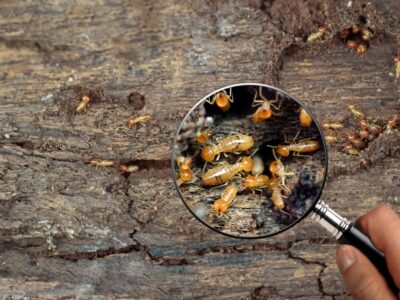Nose-Horned Viper
Vipera ammodytes
The fangs of a nose-horned viper can be as long as half an inch!
Advertisement
Nose-Horned Viper Scientific Classification
- Kingdom
- Animalia
- Phylum
- Chordata
- Class
- Reptilia
- Order
- Squamata
- Family
- Viperidae
- Genus
- Vipera
- Scientific Name
- Vipera ammodytes
Read our Complete Guide to Classification of Animals.
Nose-Horned Viper Conservation Status
Nose-Horned Viper Facts
- Prey
- Rodents, rabbits, birds
- Fun Fact
- The fangs of a nose-horned viper can be as long as half an inch!
- Litter Size
- 1-20 snakelets
- Habitat
- Shrublands, the edges of forests, and rocky hillsides
View all of the Nose-Horned Viper images!
Nose-horned vipers have potent venom. However, they are not aggressive snakes and will try to move away from a threat if possible.
The most noticeable thing about the nose-horned viper is the fleshy horn atop its snout. This viper grows to a size of 2.5 feet to a little over 3 feet long. It lives on the outskirts of forests, shrublands, and on rocky hillsides in areas of Europe. This snake has a carnivorous diet of small mammals and birds. Though this viper has potent venom, it’s not an aggressive reptile.

4 Amazing Nose-Horned Viper Facts!
- It gives live birth to a litter of one to 20 snakelets.
- Herpetologists do not know the purpose of the horn on its snout.
- Its fangs can be up to half an inch in length.
- Though its venom is highly potent there have been few deaths as a result of its bite.
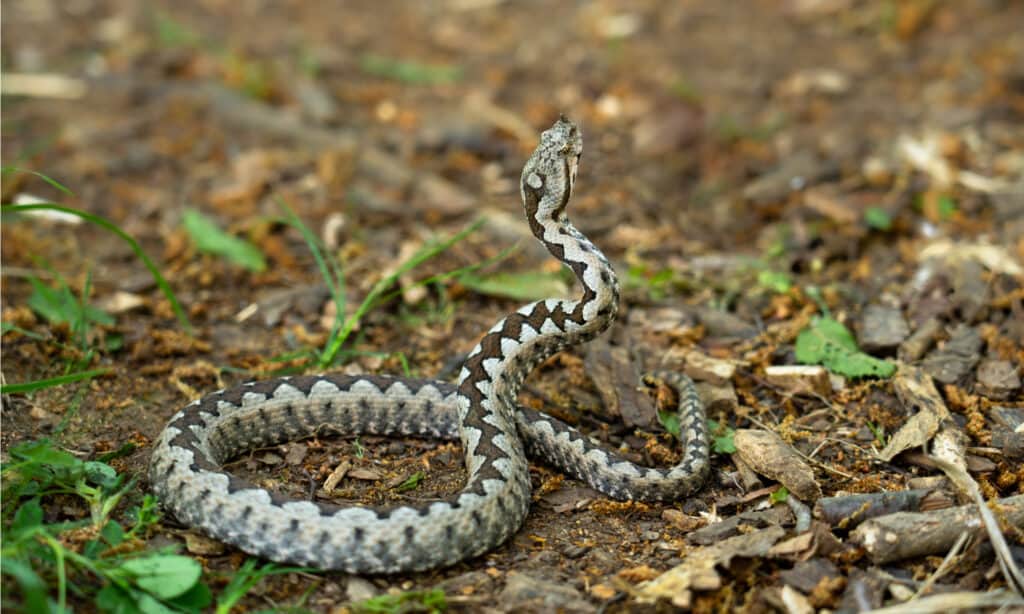
While the nose-horned viper is venomous, there have been few fatalities from bites.
©Baraian Gheorghe Cristian/Shutterstock.com
Scientific Name
The scientific name of the nose-horned viper is Vipera ammodytes. The word Vipera means viper and the Greek word ammodytes translates to sand burrower. This is a little misleading because the nose-horned viper lives in a rocky habitat.
It’s also called the horned viper, long-nosed viper, common sand viper, common sand adder, sand adder, sand viper, and sand natter.
Evolution and Origins
The nose-horned viper belongs to the Vipera genus of palaearctic vipers and Eurasian vipers. Fossil evidence of the oldest species of this genus, the Vipera antiqua, dates back 22.5 million years ago to the Early Miocene from Southern Germany.
In ancient times, the nose-horned viper was associated with the Greek god Dionysus (and equivalent Bacchus, the Roman god of agriculture, wine, and fertility), joining his followers in their religious processions.
It’s believed that viper’s venom was used to stimulate milk production in young female followers so they could work as wet nurses. The Furies were shown as being imbued with viper venom.

The nose-horned viper was associated with ancient Greek and Roman gods in antiquity.
©Zwiebackesser/Shutterstock.com
Types of Nose-Horned Vipers
The nose-horned viper has a few widely recognized subspecies, including the nominate subspecies, that can be differentiated by appearance and habitat location and take the common name of sand viper. They are:
- Western sand viper (Vipera ammodytes ammodytes): This viper is present in Bosnia and Bulgaria.
- Eastern sand viper (Vipera ammodytes meridionalis): This subspecies can be found in Albania, Bulgaria, Greece, Romania, Serbia, and Turkey.
- Transdanubian sand viper (Vipera ammodytes montandoni): This snake lives in Bulgaria, Romania, and Turkey.
Some scientists believe the Transcaucasian sand viper (Vipera ammodytes transcaucasiana), which is in Georgia and north Turkish Anatolia, is a subspecies, while others categorize it as a separate species. Vipera ammodytes ruffoi with a population in Italy and Vipera ammodytes gregorwallneri — which can be found in Austria, Bosnia-Herzegovina, Croatia, Montenegro, North Macedonia, Serbia, and Slovenia — are both considered by many as synonymous with the Western sand viper, although some class them as subspecies.
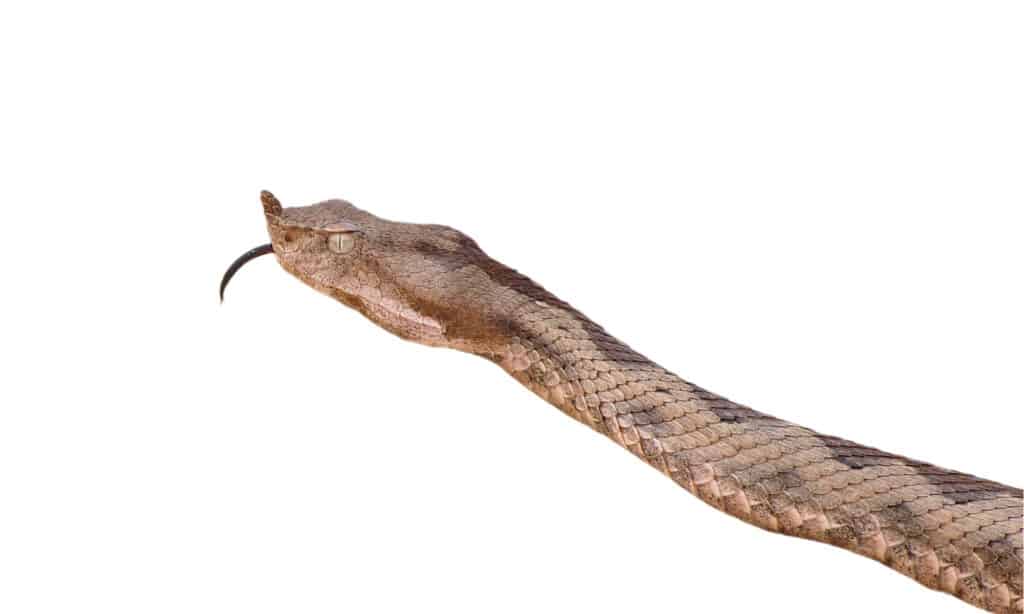
There are at least three recognized subspecies of nose-horned vipers.
©xpixel/Shutterstock.com
The nose-horned viper is a member of the Viperidae family along with more than 200 other species of snakes. Some of the other snakes with horn-like structures in the Viperidae family include:
- Rhinoceros viper (Bitis nasicornis): This snake gets its name from the four horn-like structures on its snout. While the nose-horned viper is brown and black, the rhinoceros viper has a colorful diamond and triangle pattern featuring blue, green, yellow, red, and black. It lives in a rainforest habitat in western and central Africa.
- Desert horned viper (Cerastes cerastes): This snake has a pair of horn-like structures on the top of its head. Its range in Africa extends from Morocco moving east through the Sahara Desert to Egypt. At two feet long this snake is smaller in size than a nose-horned viper.
- Arabian horned viper (Cerastes gasperettii): The Arabian horned viper has a pair of horns on top of its head. It lives in a shrubland habitat in Saudi Arabia, Yemen, Iran, Iraq, Jordan, Kuwait, and Israel. They can grow to a size of 33 inches.
- Gaboon viper (Bitis gabonica): This viper lives in sub-Saharan Africa in a rainforest habitat. Though the nose-horned viper has very long fangs, the Gaboon viper’s fangs are longer at a length of two inches!
Similar animals are the common European adder, bush viper, and sand viper.
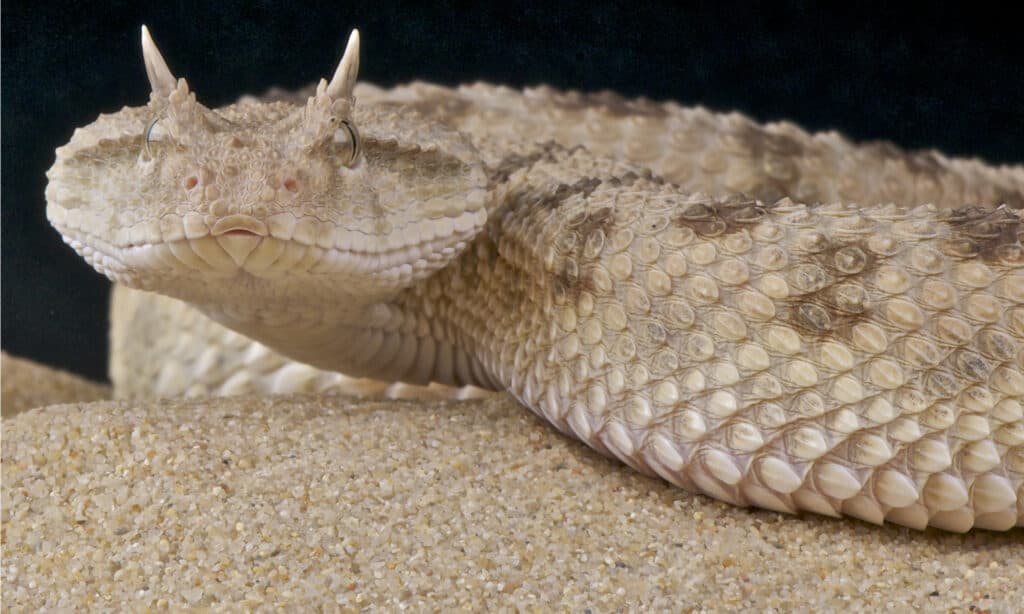
The desert horned viper is also a member of the
Viperidaefamily.
©reptiles4all/Shutterstock.com
Appearance
Male and female nose-horned vipers are different in appearance. Males have a background of gray or brown scales with a pattern of dark brown or black zigzags running down their backs. Males also have a black V-shaped marking on their heads along with a black stripe next to each eye. Female nose-horned vipers have a similar pattern, but their colors are not as distinct. Plus, females don’t have a V-shaped marking on their heads.
Both males and females have a horn-like structure on the end of their snout. Their eyes are copper-colored with a black, vertical pupil. This snake’s belly is cream or yellow scattered with dark spots.
The size of the nose-horned viper ranges from two feet to a little over three feet in length. The fangs of this viper can measure up to half an inch in length. Its tongue is black.
How to identify a nose-horned viper:
- Gray or brown with dark brown or black scales in a zigzag pattern
- A black stripe next to each eye
- Males have a black V-shaped mark on the top of their head
- A fleshy, horn-like structure on its snout measuring about one-quarter inch long
- Copper-colored eyes with black, vertical pupils
- Cream or yellow underbelly with black spots.
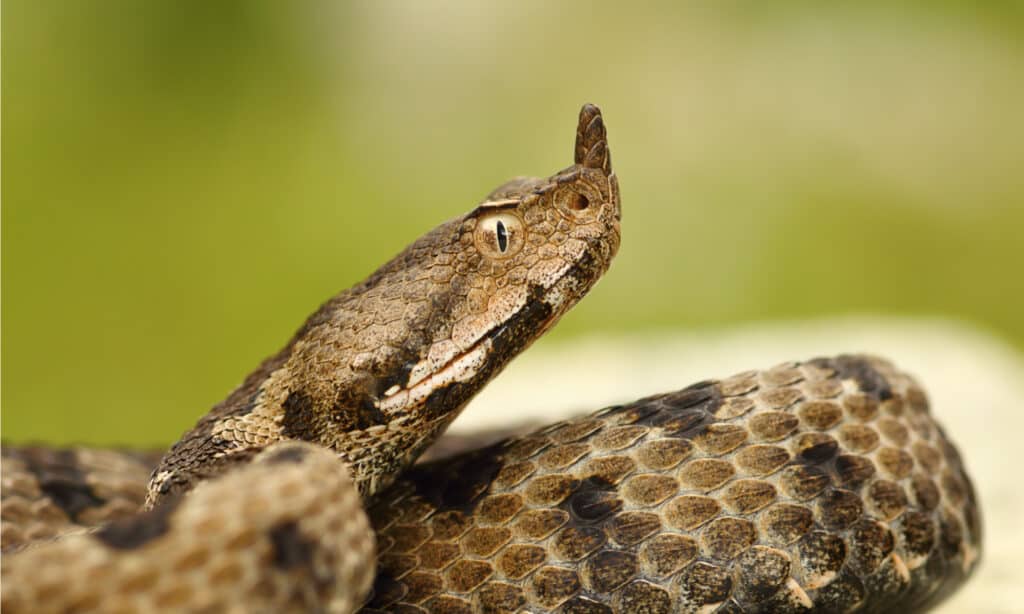
Female nosed-horned vipers do not have V-shaped markings on their heads.
©taviphoto/Shutterstock.com
Behavior
Nose-horned vipers are not aggressive. They are timid but will bite if they feel cornered or at risk of injury. If a person sees or encounters this snake while walking in a rocky area or grassland, it’s best to move away from it.
As a note, nose-horned vipers have different reactions to threats. One viper may freeze when it sees a person or predator approaching. Another viper may try to escape to a tree or pile of brush. In short, the first self-protective reaction of this viper is not always a bite.
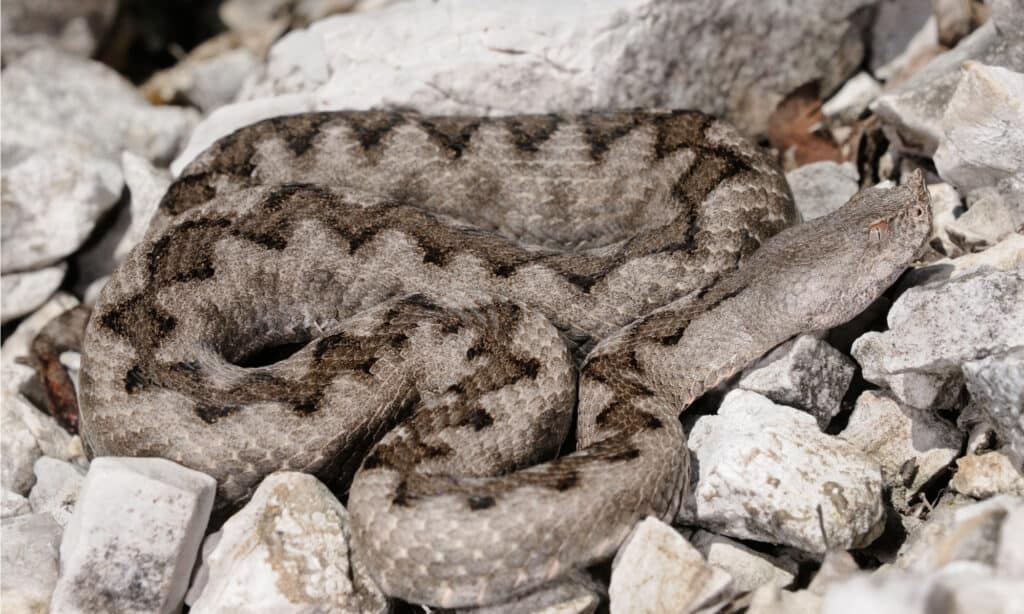
Nose-horned vipers are not aggressive and will only bite if threatened.
©Matteo photos/Shutterstock.com
Venom: How Dangerous Are They?
Nose-horned vipers have potent venom. However, they are not aggressive snakes. They will try to move away from a threat if possible. A bite from this snake usually occurs by accident. For instance, a person may get a bite after accidentally stepping on this snake while walking in a grassy area.
If someone does get a bite from a nose-horned viper it’s important to keep the individual calm and still. Call for emergency medical services right away. Help the person to remove jewelry or watches that may become an issue if swelling occurs. Keep the bite area lower than the level of the person’s heart. Stop all unnecessary movements until medical personnel arrives. Avoid putting ice on the bite area and don’t try to cut into it in an effort to remove the venom.
Fortunately, there have been very few deaths as a result of the bite of a nose-horned viper. But the risk of death goes up if the person does not seek treatment for this viper’s bite right away.

Seek immediate medical attention if bitten by a nose-horned viper.
©iStock.com/taviphoto
Habitat
The nose-horned viper makes its home in a few different types of habitats including the edges of forests, shrublands, and rocky hillsides of Europe. They inhabit a temperate climate and go into brumation (a state of inactivity) with the arrival of cold weather. These reptiles are especially active from April to May during their mating season.
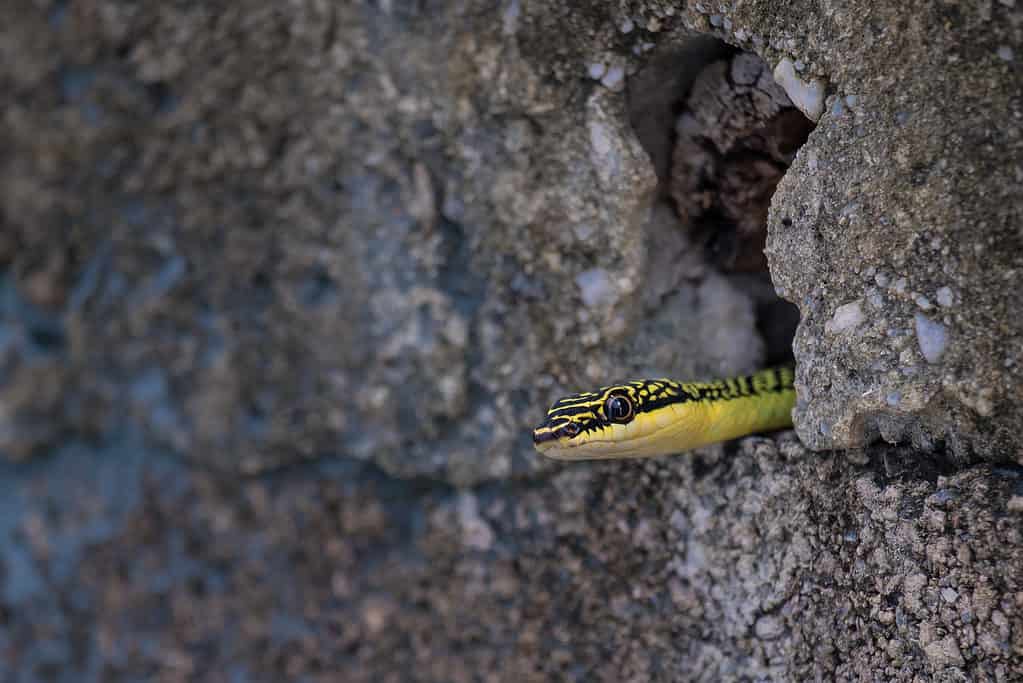
Snakes enter a state of brumation to survive the winter.
©Attapol Yiemsiriwut/Shutterstock.com
Diet
Adult nose-horned vipers typically eat small mammals such as rats, mice, and rabbits. Birds, large insects, and occasionally other snakes, including its own species, are also part of its diet. Young vipers primarily feed on lizards and eat centipedes as well.
Nose-horned vipers travel through their shrubland or rocky habitat trying to pick up the scent of their prey. Once they detect the chemical scent of prey, they wait for it to appear. The method of attack and feeding depends on the size of their prey. If the prey is large, the viper will strike it, giving it a venom-filled bite, release it, track it, and then swallow it. If the prey is small, the snake will not use venom and swallow it whole.
Unlike other types of snakes, vipers usually wait for prey to come into a particular area instead of actively seeking them out. These snakes don’t eat every day. Some of them may eat once every few days depending on the size of their last meal.
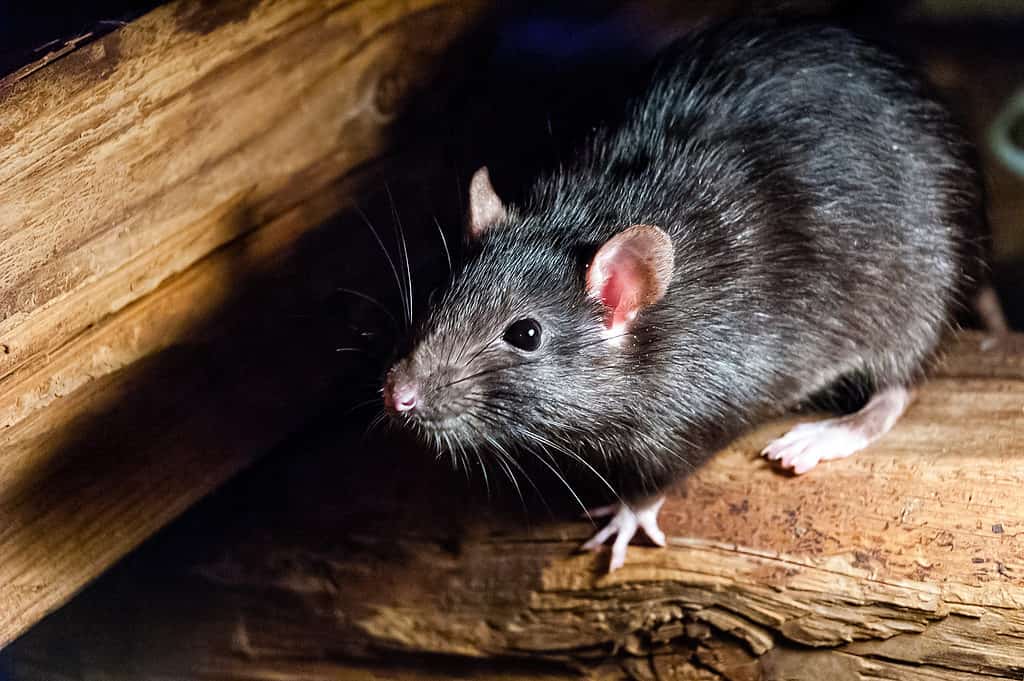
Rats are part of the nose-horned viper’s diet.
©Carlos Aranguiz/Shutterstock.com
Predators and Threats
Some reports indicate that nose-horned vipers are sometimes cannibalistic. This means a nose-horned viper can be a threat to another nose-horned viper.
Other threats these snakes face include humans illegally hunting and killing them. Some people also illegally collect them for th pet trade. People are the cause behind the loss of or decrease in suitable habitats for nose-horned vipers through land development and construction, climate change, and pollution affecting their environments.

Construction and land development create habitat loss for this snake species.
©Dushlik/Shutterstock.com
Reproduction, Babies, and Lifespan
The breeding season for these vipers occurs during spring from April to May. As part of the mating process, the males will take part in a combat dance like that of the adder. Females will give birth to 1-20 live young in summer/fall from August to October. A newborn snakelet will measure around 5.5-9.4 inches long.
The nose-horned viper can live for up to around 22 years in the wild.

A young snakelet will measure about 5.5-9.4 inches long.
©taviphoto/Shutterstock.com
Population and Conservation
The IUCN Red List of Threatened Species categorizes the nose-horned viper as Least Concern.
Its population is not known, but its numbers are described as decreasing.

The IUCN Red List classifies the nose-horned viper as of Least Concern.
©Tobias Arhelger/Shutterstock.com
Similar Animals
View all 65 animals that start with NNose-Horned Viper FAQs (Frequently Asked Questions)
Are nose-horned vipers venomous?
Yes. These vipers have a potent venom that is deadly to their prey and can be dangerous to humans.
How do nose-horned vipers hunt?
Nose-horned vipers travel through their shrubland or rocky habitat trying to pick up the scent of their prey. Once they detect the chemical scent of prey, they wait for it to appear. When it does, the viper gives it a venomous bite. The dead prey is swallowed whole by this snake.
Vipers have a reputation for being lethargic. Unlike other types of snakes, vipers usually wait for prey to come into a particular area instead of actively seeking them out.
Are nose-horned vipers aggressive?
No, though the horn on their snout and their vertical pupils make them appear threatening, these snakes are not aggressive.
Where do nose-horned vipers live?
These vipers live in Europe specifically in Albania, Austria, Bosnia, Herzegovina, Bulgaria, Croatia, Greece, Georgia, Italy, Montenegro, North Macedonia, Romania, Serbia, Slovenia, and Turkey.
Their habitat is shrublands, the edges of forests, and rocky hillsides.
What do nose-horned vipers eat?
They eat a diet of small mammals such as rats, mice, and rabbits. Birds are also a part of this viper’s diet. These snakes don’t eat every day. Some of them may eat once every few days depending on the size of their last meal.
How venomous is the nose-horned viper?
Their venom is very potent. It quickly kills its prey of small mammals.
How many types of nose-horned vipers are there?
A number of subspecies of the nose-horned viper have been formally recognized: the Western sand viper (Vipera ammodytes ammodytes), Eastern sand viper (Vipera ammodytes meridionalis), and Transdanubian sand viper (Vipera ammodytes montandoni). There are a few more disputed subspecies that have been proposed by scientists.
Can a nose-horned viper kill a human?
Though rare, deaths have occurred as a result of this viper’s bite. It’s important to seek medical treatment right away after getting a bite from this venomous snake.
Thank you for reading! Have some feedback for us? Contact the AZ Animals editorial team.
Sources
- IUCN Redlist, Available here: https://www.iucnredlist.org/species/62255/12584303
- Virginia Zoo, Available here: https://virginiazoo.org/animal/rhinoceros-viper/
- Wikipedia, Available here: https://en.wikipedia.org/wiki/Vipera_ammodytes
- Desert USA, Available here: https://www.desertusa.com/animals/horned_viper.html
- Toxicology, Available here: http://toxicology.ucsd.edu/Snakebite%20Protocols/Longnose.htm
- Reptile Talk, Available here: https://www.reptiletalk.net/nose-horned-viper/
- Wikipedia, Available here: https://en.wikipedia.org/wiki/Gaboon_viper
- IUCN Redlist, Available here: https://www.iucnredlist.org/species/13300910/13300919









